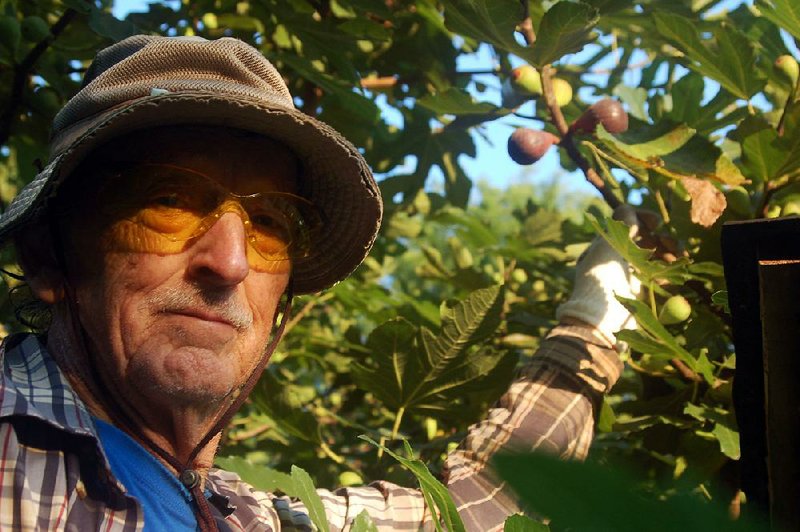In a state that produces more rice than any other and is near the top in poultry production, Marvin Smith of North Little Rock has the Arkansas fig market cornered.
Smith has been in the fig business for 25 of his 75 years. "I wish I'd started this when I was a younger man," he told a recent visitor to his homestead farm in the Rose City addition of North Little Rock.
On that particular morning -- the hottest, most humid morning to date in North Little Rock this year -- Smith strapped on a miner's headlamp well before sunrise to fill a Little Rock pizzeria's order for 45 pounds of figs.
"You can't layer them too deep," he said, carrying a plastic tray that was filled only two or three deep in figs. "They're delicate and bruise easily."
"I am 75 years old" -- Smith likes pointing that out -- "and I've been growing these 24, 25 years now. It's like raising rabbits. You bring one home. Your daughter brings one home. Then you have more rabbits."
These "rabbits," he said, love his soil -- a sandy loam. "I could put a dead stump out here, water it, and it'd grow back," he joked.
Smith lives and farms on 7 acres nestled in trees and shrubs just north of U.S. 165 and an empty field south of a Rose City neighborhood of several hundred homes. Besides having a typical backyard vegetable garden, Smith has 40 trees that produce nine varieties of figs.
"I've probably got more figs than anybody in Arkansas," Smith said. "If anybody's got more than I do, I don't know who they are, but I'd like to meet them."
Such a grower won't be at the University of Arkansas.
While the UA System's Agriculture Division produces world-class research on a variety of topics (weed science, blueberries and rice, among others), fig production isn't among them.
Without any commercial fig production in the state to speak of, UA's research into the fruit is limited, said Amanda McWhirt, a horticulturalist with UA's cooperative extension service.
The Celeste and the Brown Turkey figs are most common in Arkansas, McWhirt said. "To have nine varieties in Arkansas, I'd say, is at least very different," she said.
The Celeste and Brown Turkey figs are mostly found in backyards, and UA specialists receive a lot of calls on how to care for the fig trees, she said. "It's not a really deep-rooted plant," McWhirt said. "A sandy loam will hold water better but it won't hold too much water. It's sandy, but not too clay-ey."
Figs also aren't affected as badly by fungal diseases and insects as apples and peaches are, resulting in little or no need to spray herbicides or pesticides, McWhirt said.
McWhirt, like Smith, noted that harsher winters, even in Arkansas, once kept fig plants to no more than fig "bushes." Milder winters over the past 12 to 15 years have allowed bushes to grow into trees.
A backyard fig farmer also can help a fig bush grow taller by pruning offshoots growing from the main trunk.
"You trim those back, and you'll have limbs reaching for the sun," Smith said.
Smith can rattle off his varieties: "The Celeste, the Brown Turkey, Chicago, Texas Brown Turkey, Texas Blue, the Texas Everbearing..."
He also grows and sells bamboo, but saves the thickest, sturdiest sections of that invasive stalk for the network of scaffolding he has constructed around some of his wider, taller trees.
He once traded 100 pounds of figs to a fellow who was intent on making fig wine, in return for some of the finished product. "He brought me back muscadine wine," he said, offering a look somewhere between grin and grimace lightened by a twinkle in the eye.
Birds -- more than the Arkansas winter -- are the biggest threat to his crop.
"Starlings -- they're especially bad, because they come in flocks," he said. "Robins, too. And sparrows. Coons. Possums. And the deer. Orioles. Bluejays. Pretty much every bird but the crow and pigeon."
At the suggestion of a friend, Smith put a hollow, plastic cat about 5 feet tall and 4 feet around in the upper reaches of one tree to ward off birds. "It didn't work," Smith deadpanned. Yet the cat remains, and he has far too many trees to cover in netting.
Still, he doesn't begrudge the birds their daily feed. "Birds neither reap nor sow, yet the heavenly father provides for them," Smith said, paraphrasing Matthew 6:26.
What figs he doesn't sell to local businesses and direct to consumers who come to his farm, Smith sells at the North Little Rock farmers market every Saturday. His daughter set up a Facebook page for him -- Fig Man -- but, otherwise, his business comes by word of mouth.
He grew up about 2 miles away, where his father "had a truck patch" and sold his garden bounty at roadside stands.
Asked if figs were a hobby or a living, Smith reflected for nearly a minute.
"Well, it's certainly not a living, but it's more serious than a hobby," he said. "It's something I like to do. God has blessed me. I'm 75 years old, and I'm still able to do this? I'd say that's pretty good."
Business on 07/28/2017
